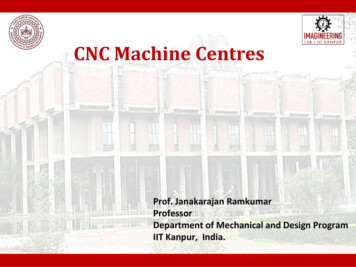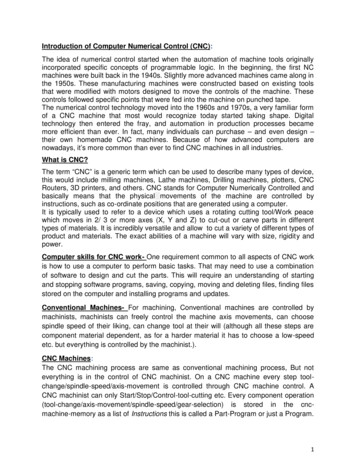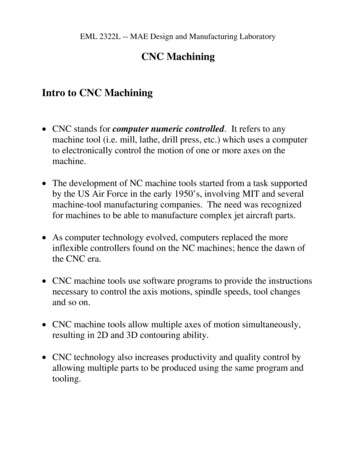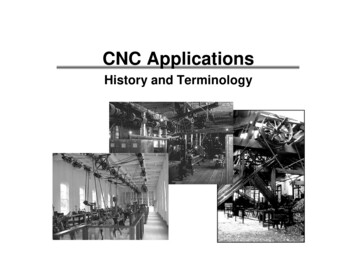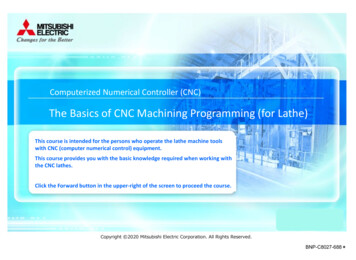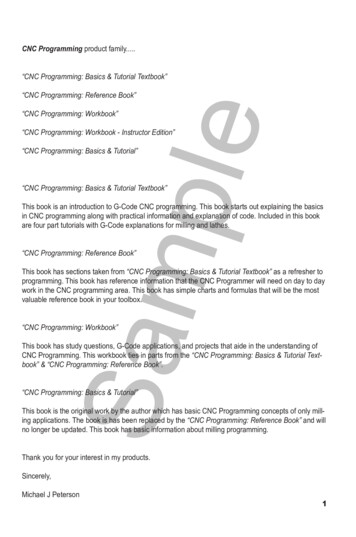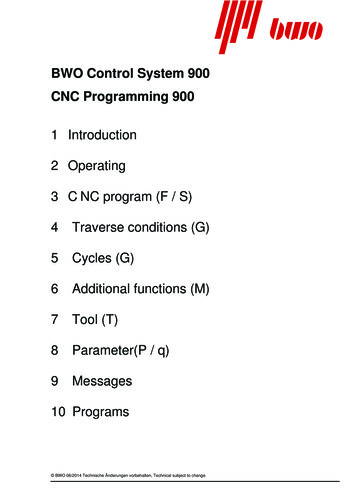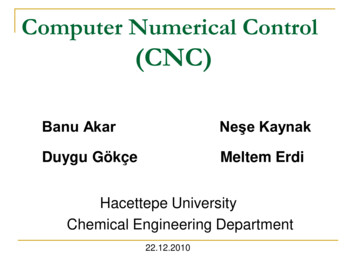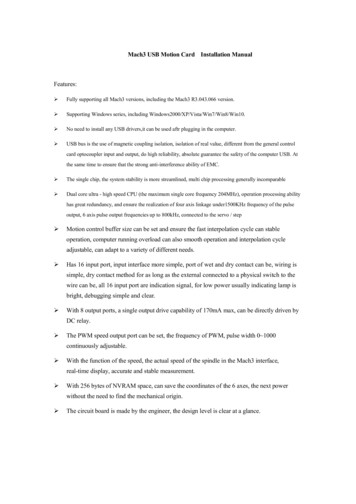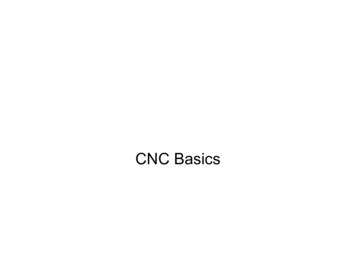
Transcription
CNC Basics
Introduction Computerized numericalcontrol (CNC) machines– Perform complexoperations faster, moreaccurately andconsistentlyExamples of some workpieces producedby CNC machines.
A CNC lathe.
CNC turning center.
A CNC milling machine.
A CNC machining center.
The CNC Machine Control Unit CNC program created & stored in MCU(machine control unit)An operator control panelmounted on the exterior ofthe machine control unit.
CNC Motion Control Machine locates axes from programmed commands Components: drive screws, CNC guideways, servomotors
A ballscrew assembly.
A linear guide assembly andits parts.
Coordinate Systems Programs tell machine function and where toperform it Coordinate system maps locations Cartesian/rectangular system maps positive/negativevalues on X- and Y- axes relative to origin Polar system locates points by angle and distance fromorigin
The parts of a servo motor.
The parts of the Cartesian coordinatesystem.
Quadrants separate a coordinate plane into fourregions.
A diagram showing the polarcoordinate system. Whenusing this system, the X-valuespecifies the distance fromthe origin, and the Y-valuespecifies the angle relative tothe zero degree mark. Theposition “A” shown is locatedat an angle of 45 and adistance of 8.0" from theorigin; when using the polarcoordinate system this iswritten as X8.0 Y45.0
An example of how eachposition in an eight-holeworkpiece can be identifiedusing polar coordinates. Thepositions for each locationare programmed as: (A) X7.0Y0; (B) X7.0 Y45.0; (C) X7.0Y 90.0; (D) X7.0 Y135.0; (E)X7.0 Y180.0; (F) X7.0Y225.0; (G) X7.0 Y270.0; (H)X7.0 Y315.0
Positioning Systems Absolute positioning system references all positionsrelative to origin Incremental positioning system specifies distancefrom current position to next
Assume that each block on thegrid equals 1". Using theabsolute programming method,the coordinates for eachidentified location are: (A) X6.0Y6.0; (B) X-6.0 Y6; (C) X-6.0 Y6; (D) X6.0 Y-6.0.
Assume that each block onthe grid equals 1". Using theincremental programmingmethod, assuming thecutting tool is already atposition A, the coordinatesfor each following locationare: (B) X-12.0 Y0; (C) X0.0Y-12; (D) X12.0 Y0.0
Codes Codes tell machine what to do at position G-codes: preparatory commands (set mode)M-codes: miscellaneous functions (on/off)Other word address commandsBinary
An example of the parameter numbering format. Notice the parameter numberis 0401 and the bits are read in sequence from right to left. Each bit can beeither a ‘0’ or a ‘1’.
Conversational-Type Programming Operator selects function and machine prompts formore information
Parts of a CNC Program Safe-start: clears machine for new operation Material removal: performs operations Program ending: safely positions tool & axes out ofthe way
The program begins by the tool being loaded, the spindle being started,and the tool being rapid positioned to the first location.
The tool is fed to depth and then fed to each location. Once machining iscomplete, the tool is then retracted to a clearance point above the workpiece.
The tool is rapid positioned toa location far above theworkpiece. The coolant isturned off and the program isended.
Introduction to CNC Milling
Introduction CNC milling machinesperform samefunctions as manual,and creates arcs,contours and 3DsurfacesCNC milling machines can producecomplex part surfaces that would bevirtually impossible to produce withmanual milling machines.
Types of CNC Milling Machines Two classes of machining centers: Vertical spindle and horizontal spindle Types of milling machines: vertical and horizontalmachining centers (VMC and HMC) ATC types: carousel-type and swing-arm-type
A vertical CNC milling machineA vertical machining center
A vertical machining center (VMC). Noticethe similarities to a manual vertical millingmachine.
A horizontal machining center (HMC). Notice the orientation of the spindle,table, and ATC.
A manufacturing cell with multiple CNC machining centers andautomated part handling.
A carousel-type ATC.
The swing-arm-type ATC changes tools much faster thanthe carousel-type ATC.
Toolholding Toolholding CNC spindle types and toolattachment styles Workholding: manydevices availableNational Machine Tool Builder(NMTB) toolholders in 30, 35, 40, 45,and 50 size tapers.
Retention knobs thread intotapered toolholders tosecure the holder in themachine spindle.
A cutaway view showing the many parts of a milling spindle. Notice how theball gripper mechanism at the end of the drawbar grasps the retention knob.Spring tension from a series of disc springs pulls on the drawbar to securethe toolholder taper.
A CAT holder and a BT holder. Notice the difference in thesize of the flanges and the location of the grooves.
A collet chuck grips a tool shank by tightening thethreaded cap.
(A) ER-, (B) TG-, and (C) DAstyle collets.
(A) The groove on an ER collet snaps into a retaining ring in the threaded cap andthe cap is then threaded into the collet chuck. (B) DA collets slip into the chuck andthen the cap is threaded onto the chuck. (C) The toolholder is then mounted in abench-top clamping device, the tool is inserted in the collet, and the cap istightened.All images Copyright 2015 Cengage Learning .
(A) A shrink-fit toolholder.(B) The machine that assembles anddisassembles shrink-fit tooling.
FIGURE 8.5.16(A) A key-typechuck with a quickchange size 30NMTB taperand (B) a keylesschuck with a CATtype flange.
A face mill and toolholder.
An ER collet with an internal square for holding tapsrigidly.
(A) A quick-change tap adapter designed to quickly mount taps into a(B) floating holder.
Step clampsToggle clampsToe clamps
A large workpiece clamped to the table of a VMC using step clamps.
A vise with two moveable jaws can hold two parts in one setup.
This multi-sided vertical doublevise has machinable aluminumjaws, or soft jaws, that can bemachined to match the shapeof the workpiece. Soft jaws canalso be made of soft steel orcast iron.
Manual collet fixturesA programmable CNC rotary axis
This machining center has an APC that uses six pallets. The machine can beprogrammed to load any of the pallets automatically. Work is loaded on each pallet atthe station on the right side of the APC.
The tombstone tower in (A) can be machined as needed for mounting workor other workholding devices. The tombstone tower in (B) has fourintegrated vises, one on each of the four sides of the tower.
A custom fixture designed and built to hold an oddlyshaped pump housing.
Process Planning Manufacturing process: all operations required tomachine a part Process plan describes all steps in detail Includes a description of each operation, the toolsrequired, speed and feed data, workholding information,other notes and comments, and often a sketch depictingthe part orientation
CNC Milling: Setup and Operation
Machine Control Panel Attached to MCU,contains displays andinputs Allows operator toprogram, set up andoperate machineThe parts of a machiningcenter control panel.
Soft keys are used on some machines. These keys are universal and can beused for different functions according to their on-screen label.
Arrow keys used for constant jogging of each axis.
A spindle speed, feed rate, and rapid override control.
Workholding Setup Inspect/clean vises and fixtures Allow proper height in the vise jaws Set clamps to avoid collisions Special attention to overall height Use the same torque on clamp fasteners and visescrews Prevent distortion
Machine and Work CoordinateSystems Cartesian coordinatesystem WCS sets flexible origin,MCS has set originThe relationship of the machinecoordinate system (MCS) to the workcoordinate system (WCS).
Power-up and Homing Power up machine properly Machine home position of the MCS Select “zero-return” or “home” mode on control panel Jog each axis towards home position Most machines will automatically complete theprocedure Machine will zero the machine coordinate system
Work Offset Setting Difference betweenMCS and WCS on X-, Yand Z-axesWorkpiece offset, or workshift, is thedistance from the MCS origin to thedesired location of the WCS origin.
This front view shows a VMC spindle face and a gage block being used todetermine the Z-axis work offset. Note the relationship of the MCS to the WCS.
An edge is located with an edge finder.
Finding the center of a hole bysweeping with a dial indicator.
A dimensioned example of how a work offset is derived for a workpiecehaving the origin in the front left corner.
This top view shows that when a hole center is to be used as the X/Ylocation of the work origin, the hole center can be found by sweepingwith a dial indicator. This aligns the spindle centerline with the holecenterline.
Cutting Tools Installation: seeSection 8.5 Offset types: Tool height, geometry,wearTool length is measured from thegage line on the tool holder’s taperto the tool tip.
A VMC Z-axis can be used to measure tool length. The length offset is found bytouching the tool tip off of the work Z-zero surface with a feeler gage and thensubtracting the feeler gage thickness. The objective is to determine the dimensionlabeled “Final actual tool length.”
A typical milling geometry offset page on the machine display screen.These numbers reflect the tool length from gage line to the tool tip in itsoriginal and unworn state.
The way a VMC Z-axis can be used to measure tool length can be compared tothe way a micrometer measures.
A typical milling wear offset page on the machine display screen. The numberthat will be entered into the wear offset will be an incremental adjustment from abaseline of zero tool length wear.
Program Entry Three methods for input: Typing into control Uploading from storage Sending from PC Direct numerical control (DNC) Sometimes called drip feeding Program is fed from a PC to the control line by line
Machine Operation Prove-out beforeoperation Run auto mode onceprogram is provenA graphic part simulation on a displayscreen.
Introduction to CNC Turning
Introduction CNC turning likemanual lathe or millingmachine Z-axis motion alongslide, X-axis perpendicularThe coordinatesystem for CNCturning and therelationship of theaxes.
The origin for turning is usually located on the workpieceface on the part center line.
A slant-bed turning center has an inclined bed.
An end-working live tooling attachment for milling and performingholemaking operations on the face of a part.
An adjustable angle-head live tooling attachment allows angular millingto be performed on the turning center.
A robotic manufacturing cell can enhance productivity byminimizing operator intervention. The workpiece is transferredbetween machines by the robot.
A specialized mill/turnmachine that can performheavy milling and turningoperations.
A sub-spindle opposes the machine’smain spindle. The workpiece can betransferred from the main spindle to thesub-spindle so that the backside of theworkpiece can be machined.
Types of Turning Machines Turret-type machines, gang-tool-type machines,CNC lathes, Swiss-type turning centers
A circular turret holdsmultiple tools and canindex to any one ofthem with a programcommand.
A twin turret machine can move both turrets independently formachining.
A gang tool machine topplate with the toolsarranged in a row.
A gang tool turning center.
A CNC lathe holdscutting tools with a toolpost similar to that usedon a manual lathe.
A Swiss turning machine moves the entire workpiece in the Z-axisinstead of moving the cutting tool.
A typical toolarrangement on aSwiss turning machine.
Tool-Mounting Adapters Styles of tool-mounting adapters for differentmachines Each accepts tools differently CNC machines use same types of cutting tools as nonCNC, but different holding methods
This type of toolholding adapter bolts directly to the turretwith cap screws.
A VDI toolholding adapter mounts to the turret with a VDI shank. Theadapter is drawn tight to the turret with the serrated teeth.
A dovetail mounting system used on a gangtool machine.
Quick-change toolholders used on a CNC lathe.
A CNC collet chuck for holding holemaking tools.
The collet types shown from left to right are the ERseries, DA series, and TG series.
A Hardinge HDB drill bushing used to hold holemaking tools.
The turning tool orientations shown are right hand, neutral, and lefthand.
Cutoff inserts are available with a biased cutting edge to minimize burrson the part being cut off.
A grooving tool is in the foreground and a cutoff tool is in thebackground.
A gripping-ring-type bar puller grips the bar end by sliding a ring ofspring-steel teeth over the perimeter of the bar.
This coolant-actuated bar puller's jaws grip the stock using thehydraulic pressure of the machine’s coolant system.
A CNC turning center equipped with anautomatic bar feeder.
Workholding Workholding devices forCNC like those formanual lathes Types: workholdingcollets, workholdingchucksA CNC turning center using a colletfor workholding.
A three-jaw power-actuated chuck in a CNC turning center. This setup isusing soft jaws that were machined to match the outside diameter of theworkpiece.
Process Planning Manufacturing process: all operations required tomachine a part Process plan describes all steps in detail Includes a description of each operation, the toolsrequired, speed and feed data, workholding information,other notes and comments, and often a sketch depictingthe part orientation
CNC Turning: Setup and Operation
Machine Control Panel Attached to MCU,contains displays andinputs Allows operator toprogram, set up andoperate machineThe parts of a turning centercontrol panel.
Soft keys are used onsome machines. Thesekeys are universal andcan be used for differentfunctions according totheir on-screen label.
Arrow keys used for constant jogging of each axis.
Workholding Setup Text advises how toprepare chuck or collet Use appropriateclamping pressureAppropriately bored softchuck jaws and amating workpiece.
A turning center drawtube and collet assembly within a machine spindle.
A picture of a turning center hydraulic regulator and gaugefor adjusting collet or chuck clamping pressure.
A minimum of 1/8" clearance should be maintained betweenthe cutting tool and the workholding device.
Machine and Work CoordinateSystems WCS (work coordinatesystem) sets flexible origin MCS (machine coordinatesystem) has set origin Power up and home beforeworkingThe relationship of the machinecoordinate system (MCS) to theestablished work coordinate system(WCS).
Work Offset Setting Difference between MCS (set) and WCS (flexible) Program coordinates reference WCS; WCS referencesMCS Some controls call this offset a workshift Basic steps for setting a work offset in text
Workpiece offset is the Z-axis distance from the MCS zero to the WCSzero. The X-axis offset should remain zero since the spindle and workpieceshare the same center line.
A gage block can be used todetermine the workpiece offsetby touching a turret referencesurface on the desired part Zzero. The turret’s position willbe displayed on the machineposition page. With the turrettouching the spindle face, theposition would read Z-zero.With the turret touching thegage block as shown, theposition would display thelength of the workpiece to itsface, plus the gage blocklength. Subtracting the gageblock length from thisdimension reveals theworkpiece length from thespindle face (work offset).
Cutting Tools for Turning Installation: mount toolscorrectly for rotationdirection, check alignment Offsets: distance referenceto tool tip Geometry offsets and wearoffsetsAdjustment screws for squaring aholemaking tool holder.
Method for setting tools off the part face of Z-zero with a 0.010"-thick feelergage. While in this position the tool’s position can be set as positive 0.010"in the Z-axis.
A holeworking tool being swept with a spindle-mountedindicator to find alignment with the spindle axis.
In order for TNRC to be successful,the control must know the cuttingzone (shaded in blue) on the toolnose where compensation mustoccur. The available quadrants areshown relative to the tool tips onvarious styles of cutting tools.
Program Entry for Turning Programs can be entered three ways: Manually typing on shop floor Uploaded to memory from PC or storage Sent direct from PC as program runs Direct numerical control (DNC) A/K/A drip feeding Program fed from a PC to the control line by line
Turning Machine Operation Run program prove-outto identify mistakes Graphic simulation, dryrun, safe offset Auto mode: runningproven program withoutsupervisionA graphic part simulation on adisplay screen.
CNC milling machines perform same functions as manual, and creates arcs, contours and 3D surfaces CNC milling machines can produce complex part surfaces that would be virtually impossible
